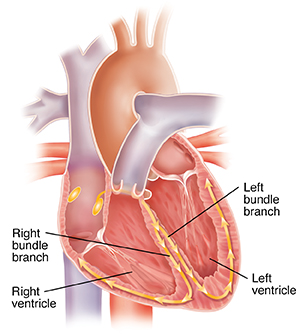Understanding Left Bundle Branch Block
Bundle branches are part of the heart's electrical "wiring" system. They let electrical signals pass through the ventricles. Each ventricle has a bundle branch, referred to as the right or left bundle branch. Bundle branch block is a problem where one of these pathways (right or left bundle) in the heart is not working correctly, causing a delay in the signal passing through. This results in the heart's main pumping chambers squeezing (contracting) out of sync. This can cause weakening of the heart and less efficient blood flow. It doesn’t usually occur in young or healthy people. It’s more common in older adults and people with serious heart disease. It can worsen the heart’s ability to pump in people with heart failure.

What is left bundle branch block?
The heart uses electrical signals to keep pumping normally. With left bundle branch block, there is a problem with the branch of the system that sends the electrical signal to the left ventricle. The signal can’t travel down this path the way it should. The signal still gets to the left ventricle, but it's slow compared with the right. Because of this, the left ventricle contracts a little later than it should. This can cause the heart to pump less efficiently. This condition may come and go, but most of the time, it's permanent.
What causes left bundle branch block?
Left bundle branch block occurs in some people with no known risk factors or heart problems. But most of the time, it's associated with some type of heart abnormality such as:
-
Any disease of the heart’s electrical system that may be seen with age
-
Severe disease of the arteries that send blood to the heart muscle (coronary artery disease)
-
Long-term high blood pressure with thickened heart muscle
-
Heart valve disease, such as aortic stenosis
-
Enlarged, weakened heart muscle (cardiomyopathy)
-
Infection of the heart muscle (myocarditis) from any cause
-
Heart attack (myocardial infarction or MI)
Symptoms of left bundle branch block
Left bundle branch block doesn’t often cause symptoms on its own. But in some cases, you may have symptoms such as:
If you have heart failure, left bundle branch block can make symptoms worse.
Diagnosing left bundle branch block
Your healthcare provider will ask about your health history and symptoms. They will give you a physical exam. You may have tests such as:
-
Electrocardiography (ECG). Sticky pads are put on your chest. Wires are attached and connected to a machine. The machine checks your heart rhythm. The results of the ECG may show changes that mean left bundle branch block. You may have left bundle branch block diagnosed while having electrocardiography (ECG) for other reasons. Left bundle branch block may be the first sign of an undiagnosed heart problem.
-
Echocardiography (echo). Sound waves are used to check the blood flow and movement of the heart.
-
Exercise stress testing. An ECG is done while you exercise. This test checks your heart under stress.
-
Cardiac CT or MRI. These tests help view the muscle layers and structures of the heart.
-
Blood tests. These are done to check fat (lipids, triglycerides, cholesterol) and sugar (glucose) levels in the blood as well as electrolyte levels, and possibly enzymes to check for heart muscle damage.
You will likely be referred to a heart doctor (cardiologist).